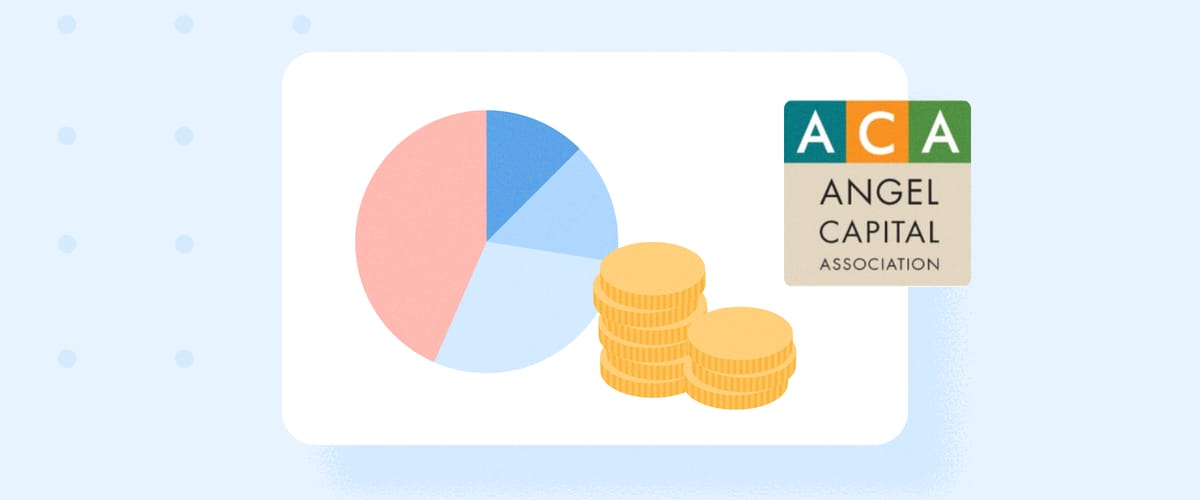In April, we celebrated Dealum’s fifth anniversary with a series of webinars together with Equidam. The webinar recordings are available on YouTube if you want to dig deeper, but to save you some time, we have prepared a summary of the core principles and methods of the Startup Valuation. You’re welcome!
About the speaker
Daniel Faloppa (founder and CEO of Equidam) has been living and breathing valuation for the past decade, with a background in finance and investment from the Rotterdam School of Management, and going on to build the startup valuation platform Equidam. Equidam started in 2013 and has valued more than 130,000 startups to date. Here’s what Daniel has learned from it.
1. Key principles
Pricing is always competitive
Pricing is always based on comparisons with other products and markets. The fewer comparisons you have, the greater the uncertainty about pricing.
As an example, think about a bottle of water in the middle of the desert – there are no good alternatives available which makes comparison impossible. It’s likely that somebody is willing to give you everything they have for the water, in that environment. If you consider art, there are no easy comparisons either – every picture is unique. The same goes for startups. They are all different and have wildly different future perspectives. So how do you evaluate them?
Value has many facets
The price reflects what people are willing to pay. People find value in things that generate utility for them and depending on the individual, value can be found in different things, for example:
- Return on capital
- Network
- Influence
- Prestige
- Environmental concerns
- Future enjoyment
However, no calculation method takes all of these components into account.
Fair market value is an abstract
When talking about return on capital, the assumption of fair market value is introduced. Fair market value is defined as “the value of the asset as exchanged by a willing buyer and seller on hypothetical fair market conditions” and regulators use this definition to decide taxation. Unfortunately, it’s a very vague starting point. When it comes to startups, Equidam's interpretation is to try and determine a price in a condition when there is more than one informed and willing buyer. They also assume that parties have a balanced and agreed upon future outlook, although, in reality, this might not always be the case.
The actual market value will always differ from the fair market value, but it’s the best starting point because not all aspects are modellable - e.g. synergies with investors or sector hype. You want to get to the value that would work in a fair market and then adjust if needed to evaluate an opportunity while still understanding the "true value" of the company.
To determine fair market value, the risk and return of the company need to be compared against the risk and return of other investment opportunities. Return is defined here as the increase in revenue and valuation in the future, and risk is the variability of that return.
2. Valuation methods
All valuation methods boil down to comparing the risk to return ratio. You're trying to understand what is the actual price for this startup, given a certain return that you think the startup can do and a certain risk compared to the other products.
There are two main categories of price calculations. On one side, methods that look at intrinsic value, looking at book value or cost-to-duplicate. On the other side, there are rudimentary comparisons like multiples, scorecards, or checklists, and more sophisticated methods such as DCF, the VC method, and real options methods. These are based on comparing the startup with other companies and the goal is to determine how this specific company differs from others.
(1) Multiples
The method is based on multiplying any underlying metric, such as EBITDA, revenue, number of users, number of square hectares of terrain where we can grow crops for an agricultural business, number of employees etc. The multiple itself is generally calculated as the average or median of multiples of similar companies.
- Quick and easy.
- Finding comparable companies and reliable data can be challenging.
- Too simplistic for early-stage companies.
Ideally, you want to find companies with the same return and risk level. It means they are at the same stage, with the same knowledge, revenue, investment, and future potential. You need at least 5-10 similar companies to determine the multiple. At an early stage and in an emerging market it can be very difficult to find similar companies and the assumption that all other companies will grow the same way as this company, have the same risk, and are priced correctly can be misleading.
(2) The scorecard method
The scorecard is more refined and suitable for an early-stage company. You decide on criteria that you want to base the valuation on, give them weight, and provide a score to the startup in each of the criteria. The resulting total score will be used as the multiplier for the average valuation of similar companies.
In simpler terms, you want to understand whether this company is better or worse than the average startup at that stage. If it's better, it deserves a higher valuation and vice versa.
- A detailed qualitative analysis of the company.
- Weights include investors’ preferences.
- An investor’s industry expertise allows a more accurate prognosis based on the experience of what is essential in a company to ensure its future success.
- Does not include much detailed financial analysis.
- Finding comparable data in the early stage is challenging.
(3) Checklist
The checklist starts with a valuation that you think is the maximum for a startup at this stage, market etc, and then understanding how much the company deserves of that maximum across a variety of criteria. Is it the best team? Then it earns full points. Is the idea super engaging? Same. On the other hand, if the product rollout has been a disaster, it deserves zero points for that.
- Gives a detailed qualitative analysis of the company.
- Investors’ preferences are taken into account.
- Doesn't have a lot of financial elements.
- Difficult to compare data.
(4) Discounted Cash Flow
DCF is focused on financials and estimates the value of an investment based on how much money it will generate in the future. It belongs to the group of methods that are universal and are used for everything, from the valuation of oil rigs to management decisions and the valuation of stocks. DCF is more relevant when the startup is at a later stage and the company’s financials are reliable.
- Allows a detailed financial analysis.
- Puts returns in a broader context.
- Little qualitative analysis.
- Sensitive to discount assumptions.
When you are trying to understand the discount rate of a startup, you're comparing the startup with other investment opportunities. For example, stock market, savings account, real estate – any investment that you can think of. The capital asset pricing model is supposed to value every type of asset as long as there is a risk and return. The problem is - it’s very dependent on assumptions. Also, if you've done DCFs in the past, you may have experienced changing the discount rate by 1%, and devaluation doubles. Not ideal.
(5) VC method
This is a robust method based on multiplying EBITDA. If you want the investment to return 10x in 10 years, for example, then you can calculate the post-money valuation based on the expected exit price and the general industry metrics. The math can be done in your head instantaneously once you know your idea of a multiplier for a certain level of risk.
The VC method keeps the perspective on the end goal. A lot of the methods, like DCF, focus on annual results and profitability, but for many startups, the important thing is the end game. Are we able to reach the end game, and what's the probability?
- Quick and easy, can be done in the head.
- Focuses on the big goal.
- Little qualitative analysis.
- Very sensitive to discount assumptions, especially with long time horizons.
- Simplistic and not precise.
One could argue the VC method takes simplicity too far. If it tells you that the valuation is between 5 and 10 million, but the proposal is 7.5 – is that high or not? The VC method is generally not the best way to understand the valuation.
(6) Real options
With real options, math takes the lead. The method is made for the stock market but is also sometimes used to evaluate startups. It tries to model the startup as a series of options of what the startup can do. Each option has a probability, return, and variance, and in the end, the startup is the sum of the futures that it can have. It’s a fascinating method, but when you need to set the probability and variance of each option, it gets very complicated very fast and doesn't add much information.
(7) Book value and cost-to-duplicate
Book value is the value in the balance sheet, and the cost-to-duplicate is how much it would cost to duplicate the same product. They give a helpful baseline, especially when you need to value the assets that are the company's main value, like real estate. It also helps in investigating the company's past.
The problem from a startup perspective is that these methods are backwards-looking and accounting rules usually result in estimating almost the lowest value you can give to the company. Also, digital businesses create a lot of intangibles that are not measurable. If you look at the book value of a painting as buying the paint and canvas, then how much value of the painting are you actually capturing?
The accounting system often considers things that are investments as costs and these are not reflected in the balance sheet. A lot of founders have only their laptops as assets on the accounts, but every other asset – e.g. the value of the brand or the value created – is not captured with this method. If you want to capture these as assets, you need to do a DCF.
3. Which method to choose?
Equidam uses a combination of five methods. Why should you use more than one method? Because each of them has a different point of view, biases, focus and take on comparing risk and returns. No method is perfect. The qualitative methods that compare startups to other startups can be used as a baseline. The VC method is relatively stable and DCF allows you to take into account the specifics of a plan, which is helpful with the early startups because their plan can change the most. This combination of methods allows considering the baseline, assets of the startup, and the future potential of the plan.
Is it worth the effort?
Yes and no. Startup prices have not been accurate for the last 15-20 years, they have been undervalued. Now valuations are higher, and risks are more understood. At their core, startup valuations are simply comparisons against other investment opportunities.
You can go from "take the given price" to the other end of the spectrum – "conduct an all-out valuation exercise". It's a question of how much you want to invest in terms of time and effort in understanding the valuation of the company? The more mature the startup, the more it makes sense to scrutinize valuation. Accelerators usually don't calculate valuations at all, they just give standard offers. But when Goldman Sachs is involved in an IPO, a super detailed valuation can be expected. With more mature startups, deeper evaluation is more exciting and valuable.
However, startup valuation does offer something valuable, even at the earliest stages: As the one KPI which combines both risk and reward, it can be used to ensure that investors and founders are on the same page in terms of expectations. It is an important thought exercise in understanding the ambition of a company, and whether the present reality and future strategy are aligned to deliver on that promise.
Sign up today
Create your company profile on the Dealum platform to find investor groups accepting fundraising applications right now
Sign up








